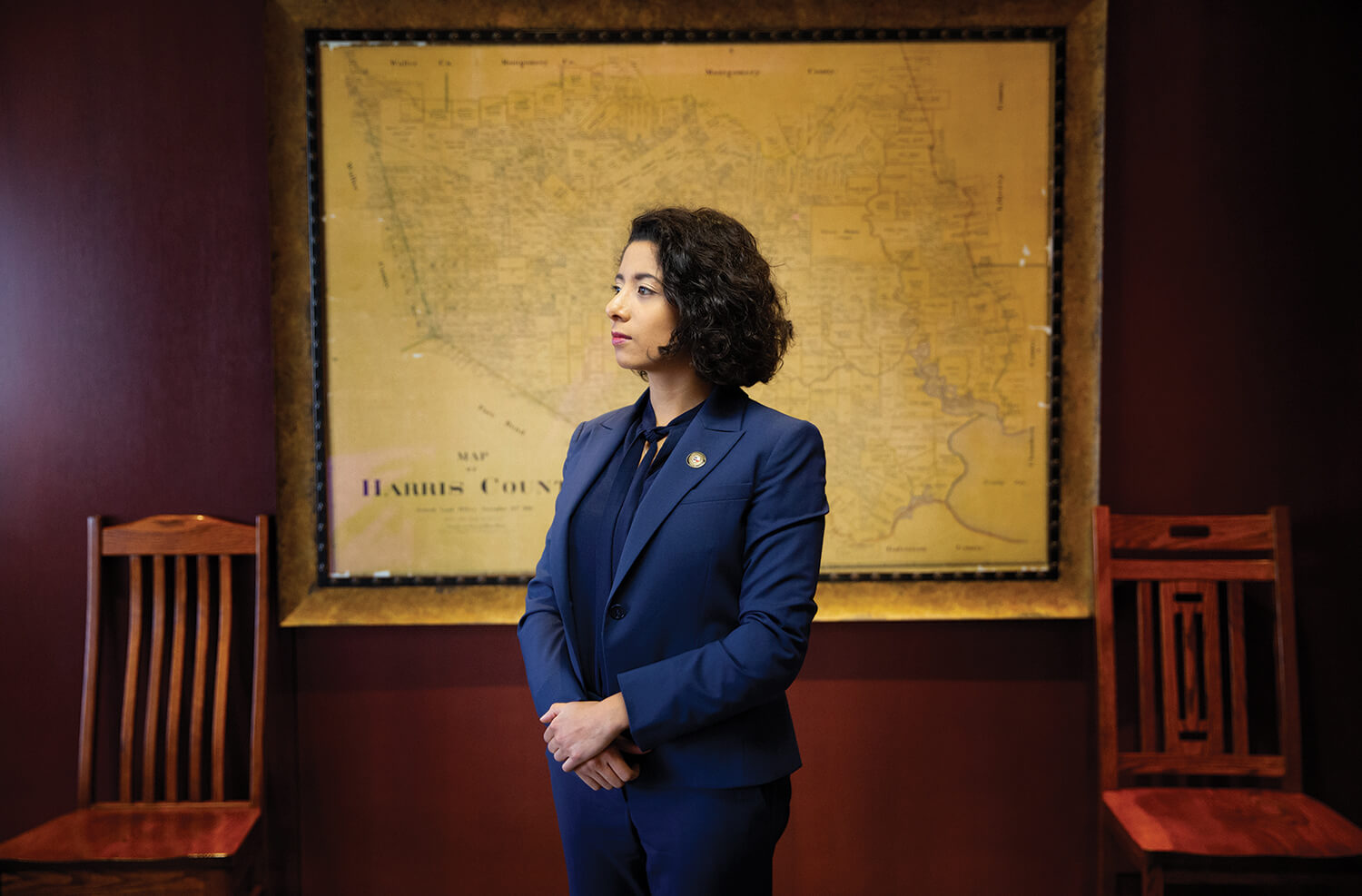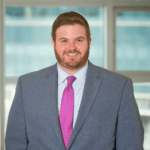Harris County Judge Lina Hidalgo talks flooding, health care and her journey to the U.S.

A year ago, LINA HIDALGO became the first woman and the first Latina to be elected County Judge in Harris County. Hidalgo, 28, serves as the presiding officer of the Harris County Commissioners Court, the county’s main governing body, which oversees a $4.3 billion budget. As Harris County Judge, Hidalgo is also the director of emergency management. The Colombia native, who immigrated to the Houston area as a teenager, decided to run for office after the 2016 election. TMC Pulse spoke with Hidalgo just a few days after Tropical Storm Imelda battered the region.
Q | I planned on asking you first about health care, but we just dealt with Tropical Storm Imelda. This was your first major flooding experience since you took office. What did you learn about managing flooding on a large scale?
A | When we came into office, we had to deal with the fires at ITC [Intercontinental Terminals Company], at chemical manufacturer KMCO, and ExxonMobil. We commissioned an independent gap analysis of our systems that was very much focused on air monitoring and enforcement of laws in these chemical facilities, but we also looked at operations and our office of emergency management. We identified gaps I inherited. We had been working on those, and that paid off in the flood. There was increased coordination—for example, there’s one website for emergency information. Folks today can go to ReadyHarris.org. It has information for survivors on how to file insurance claims, how to muck and gut a home, how to get into the system for aid that may become available. It has information for people who want to help on where to donate and where to volunteer. During the disaster, we had information on road closures and bayou and channel levels. Part of this is about consolidation and coordination; the response to these disasters is only as good as your ability to work together. Having one place where people can go is really important.
We also had a 160 percent increase in the number of high water rescue vehicles available since Hurricane Harvey. We have a department coordinating the sheriff’s assets, the constables’ assets, the fire marshal’s assets and the other departments’ rescue vehicles. We were able to meet all demand in terms of rescue. Harvey was bigger, of course, but we were able to get there.
There are other things we didn’t have time to implement. A better notification system is something that will still take a few months. Right now, people have to go online to sign up and get alerts. We have tens of thousands of people who’ve signed up, but there are millions of people in the county. Unless you signed up, you don’t get alerts unless it’s a National Weather Service alert. We require approval from the federal government for what are called “push notifications,” where folks receive an alert on their phone, whether or not they signed up.
The good news is residents listened. We could have had much worse outcomes in terms of deaths. Any death is an enormous tragedy, and when this started, I sat down with the whole team and we were thinking about what the impact might be. It was certainly less than what we expected. That tells me people did a good job doing their part, staying off the roads, not driving into deep water. We need to keep beating that drum.
Q | What about the plans in the longer term to reduce flooding in the region?
A | There’s a superhuman effort on flood control projects. They are literally decades overdue. We took an independent look at whether these projects could be done any faster. The estimate was it would take 10 to 15 years. We have it firmly at 10 years to get all of them done now. Some we can speed up. All the drainage projects were going to take five years, but now it’s going to be three-and-a-half.
We’re not afraid to ask hard questions of developers. We’re requiring them to detain more water—to use more of their land that they’ve already purchased for detention. We now know what the new rainfall rates are and that if they go with their original plans, they’ll end up flooding people downstream.
We just gave the county attorney’s office permission to file suit on flood plain regulation violators. That includes elevation requirements, fill requirements, detention requirements. They’ll basically be able to sue immediately without coming to commissioners court for approval, which helps them to be more effective.
We’re also working on a project to map flood risk. In a few months to a year, we’ll be able to tell folks what the risk is. It’s not so much whether they’re in the flood plain. It evaluates risk based on drainage and elevation, so people can know and can make their own decisions. We’re doing everything we possibly can and thinking outside the box.
Q | Dr. Umair Shah, who leads Harris County Public Health, has talked a lot about the mental health impact of going through repeated flooding. How does the county government, or the community as a whole, address what we’ve been through the last few years?
A | It’s traumatizing. To keep getting battered by something like this is a recipe to be truly emotionally affected. Part of the way we look at it is we’re all first responders in a way. We’re trying to help everybody do what they do best and match needs to resources.
More broadly, we know we face dire funding limitations from the state in terms of mental health service provision. But we also recognize that if we can do a better job coordinating existing mental health resources, we can better help people. We just passed an item to put the jail in the same medical records systems as everyone else. When you don’t have enough funds, the last thing you can do is be inefficient. Right now, our approach on mental health is to stretch every dollar by getting at coordination and efficiencies.
Q | Texas is the most uninsured state in the nation. Nearly 18 percent of residents—some 5 million people—have no health insurance. Our state government did not expand Medicaid, so much of this becomes the county’s responsibility. Here in Harris County, nearly a quarter of the population is uninsured. Beyond advocacy, what’s the long-term plan? How is this sustainable?
A | It’s a massive challenge and we’re doing it with one hand behind our back because of the refusal to expand health care through Medicaid expansion. The Episcopal Health Foundation did a study that said at least 50 percent of people in Texas have refrained from accessing health care in the last year because they couldn’t afford it. You don’t want that to be happening. How are we going to solve this problem? We commissioned an investigation that should be done later this year that aims to address precisely this question. We’re eagerly awaiting that, especially with regards to health care access on the east side of downtown. The HCA hospital there flooded during Hurricane Harvey, and there are folks who have no Spotlight hospital nearby. From our conversations with private hospitals, there’s no interest on their part in opening another one.
The other point is about social determinants of health and looking at health holistically. There’s really a movement to talk about health and not health care. Once you see people in the hospital—that should be the last resort. The question is, what can we do to be smarter about it?
Q | You have a personal connection to the Texas Medical Center, where you once worked. What was your role at the TMC?
A | I was working as a medical interpreter. They’ll send you to different hospitals. This was around 2014. I was going to UTHealth, Texas Children’s Hospital and TIRR Memorial Hermann—all over. I saw several times a mother coming in with a little boy or little girl who has prediabetes because of lack of access to healthy food. I saw the man who can’t access dialysis because of the lack of funding.
I volunteered at Ben Taub. I will never forget this. A mom was there with her daughter. The daughter suffered from mental health issues. It wasn’t their first rodeo, and the doctor and the mom were essentially telling each other—through me—that the smartest path forward was for the mom to press charges against the daughter so she could get adequate mental health care in jail. The mom had heard this before. She knew how limited the care at the emergency room was. You really see how the failure to expand Medicaid, the failure to look at health as a holistic issue, affects everyday people.
Q | Tell me about your family and the route you took to Harris County. What were your impressions when you first showed up in this community as a teenager, and what does it mean for this community to have someone like you as Harris County Judge?
A | It was a shock. I grew up going to these expensive international schools. That’s the only reason I can speak English without an accent. I knew that a big chunk of my parents’ income went to those schools. When we moved here and they said we were going to public school, I wasn’t sure what to expect. It turned out to be this incredible school that had facilities that were nicer than the ones I knew growing up in these fancy private schools.
For me, I didn’t know government could do that. I know we are far from a world where every public school is a great school. But I happened to be in a good one—Cypress Falls High School in northwest Houston—and it had nice facilities compared to what you’d see even in a private school in Latin America. There were all these sports teams. We had a film room. We were dissecting pigs in biology class. The school buses ran on time. It was incredible.
That got me thinking about how government can be a tool for good. Growing up in Colombia, government had always been something to stay away from, something very corrupt. I had always heard stories of what that corruption means. It meant violence and broken communities. That sent me on a path to hold government accountable. Of course, I learned that not all government in this country is perfect. My thinking was, ‘This is an incredible place. There’s a potential for government to be good. So how can I make sure it is doing that?’
I decided I was going to be an advocate and I was going to work around civil rights and free expression, supporting the press, artists and attorneys. Then the 2016 election happened and I decided that was too roundabout a path. I needed to just do it myself.
What my background means is we have someone with different perspectives. I bring the voice of the mothers—it’s most often mothers who were there with their children at the hospital. I bring their voices when I’m at commissioners court. There’s this deep responsibility to make the most of a society where you can shine a light on what’s broken and you don’t have to fear for your life. That, for me, is a treasure.
People say to me, ‘Why did you run? Weren’t you scared? It’s such a big position.’ Where I was born, back then at the height of the drug war, if you did something like this— journalists, opposition politicians, they die every day. The fact that you can raise questions? We have to make the most of that. I’m in a hurry to get things done.
Harris County Judge Lina Hidalgo was interviewed by TMC Communications Director Ryan Holeywell. The conversation was edited for clarity and length.





